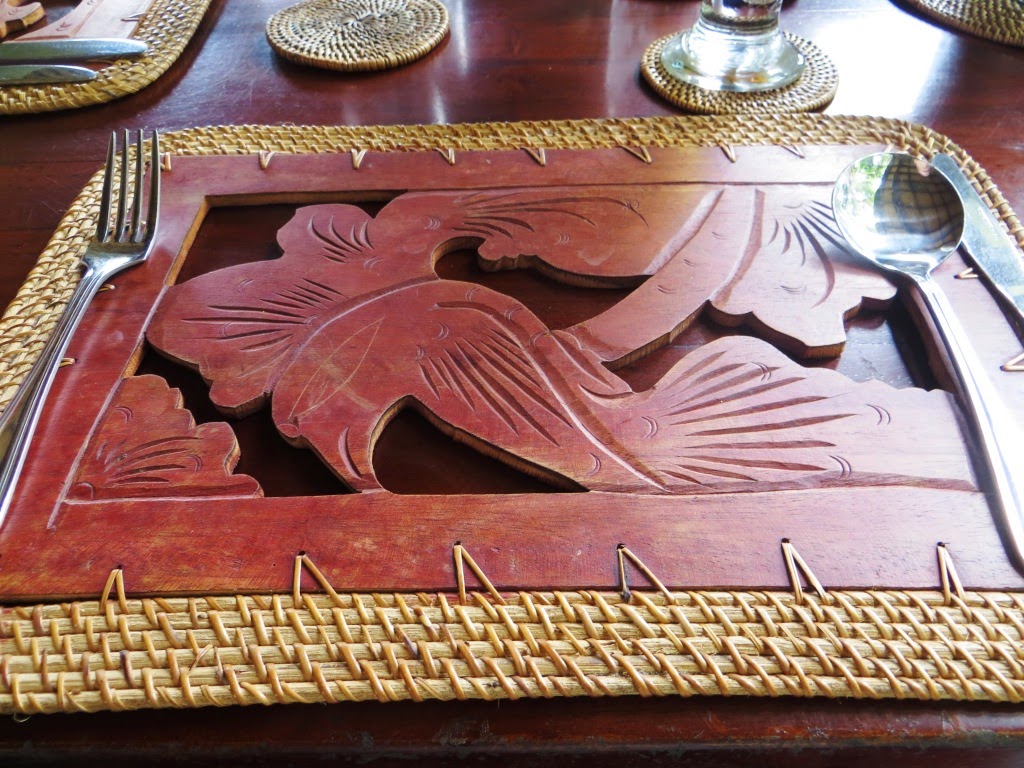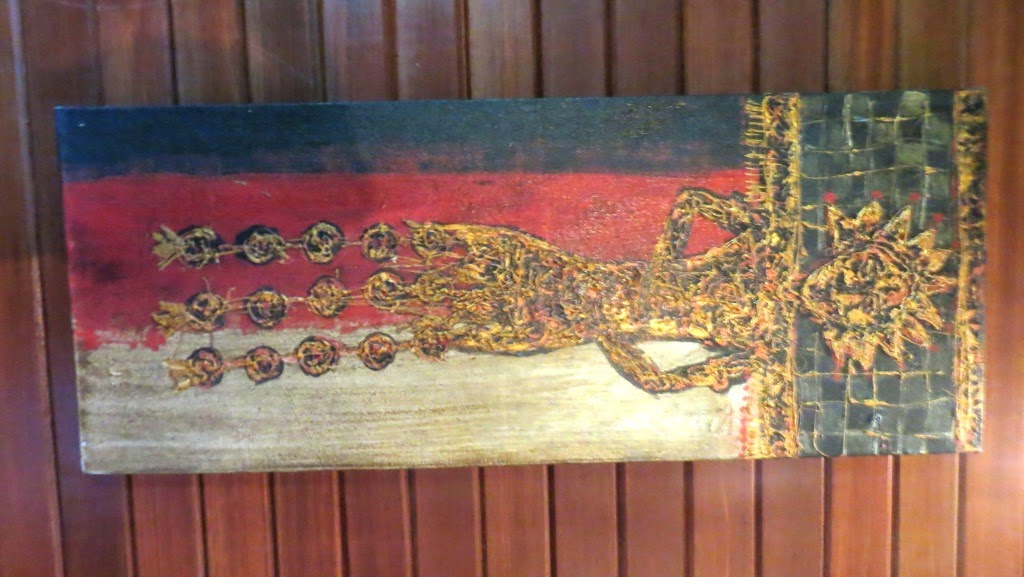12 days in Indonesia was just enough to know that Indonesia is a long chain of islands stretching from Singapore to the Philippines and that we explored only a tiny bit. When planning our year of travel. I thought a few days in Bali (surely there was more to do than sit on the beach) would be nice – there’s a
song by Redgum that kept going through my head and I had also been reading a series of spy novels by a Kiwi/Canadian who’s Aussie hero spends his time solving international problems in the wilds of Indonesia.
 |
| Leaving Auckland in the rain |
 |
| Our first gecko in months |
 |
| Stone artisans carving figures on a new building in Ubud |
 |
| Busy streets, but Ubud is still a village by Bali standards. |
 |
| Fresh flowers picked from the garden. Public bathroom at a museum. |
 |
| An offering outside our door with wishes for a good day. |
The truth is that Indonesia is the largest (by population) Islamic country in the world but it is also very tolerant of other religions. Bali has its own interesting version of Hinduism and Lombok combines their native animism quite comfortably with their version of Islam. Our guide with Intrepid, Maman, was experienced with the area even though he is from a small fishing village on Java and now lives in Jakarta. We explored the rural areas of Lombok with local guides, feasted on local food and even watched the Saturday evening wedding parades. We’ve even started to get reacclimatized to heat and humidity as we are here at the end of the rainy season.
 |
| Indonesian takeaway. Delicious. |
 |
The leaders in a big wedding party. I asked if I could take a photo,
they smiled and invited me to come to the party. |
 |
| Carrying boxes that symbolize the bride's dowry |
 |
| first musical band. They were having a great time. |
 |
The bride. She and most of the ladies had shoes with six inch heels.
The parade would be for two or three kilometers. |
 |
| The groom |
 |
| And the second band |
 |
| Mt. Rinjani. Volcano still active. Huge tourist draw for trekking |
 |
Chinese rose. No planting or care needed in the
jungle. The problem is to keep cutting down
the plants so that buildings and paths don't go back
to the forest. |
 |
Local guide, Seth, explaining that this vanilla plant takes five years
for the crop to come to maturity. |
 |
| Rice terraces. Trust me the slope is almost vertical |
 |
Pottery village. Everything is done by hand, even collecting the \
clay from the river. They are in partnership with a Dutch
group "Free Trade". |
 |
| This colour is as a result of burying the pot in sawdust. |
 |
Black ones are coconut husks and the middle ones are
painted with tamarind juice before firing. |
 |
| Stoves used only on Lombok. |
 |
| Buried in rice straw and fired for an hour. |
 |
And I can speak knowledgeably of how to make tofu. Notice
they import soybeans from America. |
 |
| Some of the pottery for sale. The motif is egg shells. |
 |
Hand weaving. The village buys cotton thread from Java and
then the ladies weave like this for 6 to 8 hours each day.
The quality of the product is not the best sadly. My
thought would be to bring in external agency to help with larger looms
like in Laos. I have become a weaving snob. |
 |
The one fascinating pattern I saw. It is called bamboo shoot
or temple. Sadly, this was not available for purchase. |
 |
We stopped on a side road to take photos of Mt. Rinjani
which had lost its clouds. These boys put on a
great show for us. |
 |
Two more scarves for the collection. I will have to start wearing
them!! |
 |
Bamboo weaving. This lady and her mother were weaving
complex items without even looking. While we struggled
to do a simple flat mat, her husband wove a simple
ring for the ladies (it has been added to my travel quilt) |
 |
These fascinating huge trees only grow in this field.
Our guide didn't know what they are, but apparently attempts
to transplant even a few kilometers away have failed. |
 |
| Collecting coral responsibly |
 |
Interesting mushrooms. At the end of
the rainy season, everything is lush and almost unnaturally coloured.
In the National Park, local are encouraged to cut down
vegetation for their animals to keep paths clear. |
 |
| Another chicken crossing the road. |
 |
Yellow cacao. the white is soft and sticky and covers the bean.
Quite tasty. |
 |
Native village. Our guide swore that the free range chickens
would fly to these baskets to lay their eggs - no hunting for eggs required.
She is the only female guide for Intrepid in Indonesia AND the first
lady trekking guide for Lombok. Quite the pioneer. |
 |
| Red cacao. Better quality cocoa. |
 |
At our hotel, there was a scale model of Mt. Rinjani. Our guide
Maman is standing where our resort is. There is a large crater
lake and a baby volcano toward the right which continues to send up steam
and spits our lava on a regular basis. The locals give offerings to
appease the spirits. |
 |
| Macaque monkeys playing in the trees on the lawn |
 |
| and on the neighboring balcony |
 |
| "Pretty bloody good" waterfall. The mist was all around us. |
 |
On the way back, heading into one of the tunnels
built 150 years ago by the Dutch. Irrigation system to
bring the river water from the waterfall down into the farming areas.
There is still a heavy Dutch presence here. |
 |
| View in the loo. Isn't this a fantastic pattern? |
 |
Our boat over to Gili T. This little fellow was very much at home
on the boat and road on the bow of the boat. |
 |
| Local transport - cindemo - on the Gilis. No motorized vehicles at all. |
 |
| I was sure these were ceramic... |
 |
| English is such a confusing language |
 |
View from the loo. Actually the "eco" shower. In Bali and Lombok,
an eco resort isn't environmentally friendly,rather it is an upscale
camp out in the wilds sort of experience. |
 |
| Goat and person napping in the heat of the day. |
 |
| Beach cows |
 |
View from the glass bottom boat. Our boat got an impromptu
bottom cleaning and the local fish flocked to
enjoy the weeds and coral being scaled off. |
 |
| local turkeys. |
Ubud is something else again. It is in the “highlands” of Bali at 200 meters so a wee bit cooler and less humid than if we were staying on the beaches farther south. It is also the center of culture on Bali as the local rulers have supported arts and artists for centuries. Although it is described as a series of neighboring villages, in reality, Bali is an island with a population of 4 million people and few buildings over two stories in height – people everywhere and most driving motorbikes. We are staying in a resort right in the village, but the way it is situated you can almost believe the frantic business on the streets isn’t there.
My reason for spending a few days in Ubud was of course to explore fabric. As a quilter, the word “Bali Batik” conjures a picture of richly coloured swirly dyed fabric with stamped motifs and my plan had been to check out the markets and bring some home for a project I have on the go. Initially, I found nothing that looked like what I expected. On Lombok they do hand weaving with a basic ikat design using low quality coarse cotton thread they import from Java. The shops in Ubud had a wealth of scarves and sarongs (many were rayon or polyester and clearly factory made, probably on Java).
 |
High end resort on the beach. Beautifully carved door and stone
frame. No need for walls. |
 |
On the way to the airport, our taxi driver stopped
a street vendor to buy a bunch of local peanuts
for us to try. Smaller but very tasty. |
 |
Monkey forest temple just a few blocks from our resort.
A lovely couple of hours in the relative quiet. |
 |
| Is this wee baby not cute? |
 |
| And a gecko of some type |
 |
Bali is Hindu but their architecture is quite different
from what we saw in India. Buildings are red and grey brick
which is then carved by stone masons. |
 |
Our resort had all these figures in the garden.
The fascinating thing was that we recognized all the
instruments from the wedding parades. |
 |
| Our eco shower (trust me, it was not lying down on the job) |
 |
| View from the shower |
 |
| And onto the floor of the shower. |
 |
| First tub bath since December in Christchurch. Ahhhhh. |
Then I had an opportunity to take a one day workshop to create my own piece of batik fabric, which was a lovely time to muck around and discover that the batik process is something I will explore further at home. I also learned that traditional Indonesian batik is very different from what we see in the fabric shops at home. Intricate designs are hand drawn or stamped on fabric and then coloured with each island having its own motifs. At the workshop I was guided by the master’s wife through her shop with the many different examples and I am bringing home a lovely piece of fabric which will become a whole cloth quilt. Not Bali Batik, but something infinitely more genuine.
 |
| Journal quilt square |
 |
I succumbed to a street vendor. His brother had
painted these batik panels. |
 |
My batik panel with design outlined in beeswax. The little tool
was surprisingly easy to use. |
 |
Our teacher - his father is the master artist and his mother
runs the commercial shop. |
 |
| A small offering for success of the workshop. |
 |
The colours painted on. The blue blotches were suggested
by my teacher to give sparkle to the ocean but I decided to not
protect them - and the dark indigo dye of the background
just covered over the mistakes. |
 |
Finished product. The orange fish are mine.
The seaweed and the other fish were added by the
master when he looked at my original drawing.
Definitely improved the composition. |
 |
| My fellow student. She is creating a ginger plant. |
Indonesia has been added to my list of places to come back to but now we are on our way to Malaysian Borneo.










































































































No comments:
Post a Comment